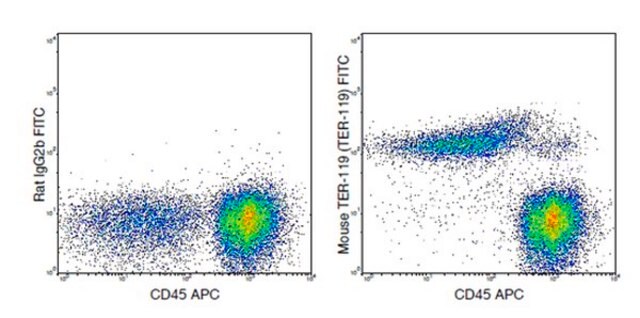推荐产品
生物源
rabbit
品質等級
共軛
unconjugated
抗體表格
affinity isolated antibody
抗體產品種類
primary antibodies
無性繁殖
polyclonal
形狀
buffered aqueous solution
分子量
antigen 32-35 kDa (doublet)
物種活性
human, canine
技術
immunoprecipitation (IP): 5-10 μg using 293-T transfected with human Sprouty 2.
indirect immunofluorescence: 2-4 μg/mL using 293-T cells transfected with human Sprouty 2.
western blot: 0.5-1.0 μg/mL using MDCK (Madin Darby canine kidney) cells.
UniProt登錄號
儲存溫度
−20°C
目標翻譯後修改
unmodified
基因資訊
human ... SPRY2(10253)
一般說明
Rabbit polyclonal anti Sprouty 2 (N-Terminal) antibody recognizes Sprouty 2 by immunoblotting (doublet at approx 32-35 kDa), immunofluorescence and immunoprecipitation.
Sprouty 2 was first isolated in Drosophila as a negative regulator of receptor tyrosine kinase signaling (RTK). In vertebrates, the family is composed of four members, Sprouty 1, 2, 3 and 4. Human Spry2 encodes 315 amino acids protein, postranslationally modified by palmytoilation, and by phosphorylation of serine and tyrosine residues. When expressed in COS cells, Spry2 is localized to the cytoplasm and co-localized with microtubule proteins. Upon EGF stimulation, it is translocated to membrane ruffles. Sprouty 1 and 2 inhibit FGF- and VEGF-induced endothelial cell proliferation, at least in part, by repressing pathways leading to p42/44 MAP kinase activation. The role of Sprouty 2 in EGF-mediated MAP kinase signaling is less clear. It was recently shown that Spry can function both as a negative and positive regulator of EGFR mediated MAP kinase signaling. Interaction of Spry2 with Cbl (an E3-ubiquitin ligase) interferes with the ability of hSpry2 to inhibit EGF signaling by specifically intercepting c-Cbl mediated effects on receptor down regulation. Phosphorylation of Spry 2 on Tyr55 leads to its association with c-Cbl. This association prevents formation of an EGF receptor-Cbl complex, consequently inhibiting ubiquitination and down regulation of the latter.
Sprouty proteins are ligand-inducible, negative regulators of RTK signaling pathways that modulate cellular growth, differentiation, and movement. Sprouty 2 (Spry2) mediates apoptosis control by c-Cbl sequestration and growth factor receptor signaling. Additionally, Spry2 downregulates EGFR ubiquitination and endocytosis, and thereby potentiates Ras/ERK signaling. Decreased Spry2 expression has been associated with poor prognosis in breast cancers . Anti-Sprouty 2 (N-Terminal) is specific for Sprouty 2 (doublet at approx. 32-35 kDa). The antibody reacts with human, dog and mouse Spry2.
免疫原
This sequence differs in one amino acid from the human sequence.
synthetic peptide corresponding to amino acids 79-98 of mouse Sprouty 2 (Spry 2), conjugated to KLH via a C-terminal added lysine residue.
應用
Anti-Sprouty 2 (N-Terminal) is suitable for use in immunoblotting using MEF lysates . The antibody can also be used for immunoprecipitation (5-10 μg using 293-T transfected with human Sprouty 2) and indirect immunofluorescence (2-4 μg/mL using 293-T cells transfected with human Sprouty 2).
Rabbit polyclonal anti Sprouty 2 (N-Terminal) antibody is used to tag Sprouty 2 for detection and quantitation by immunocytochemical and immunohistochemical (IHC) techniques. It is used as a probe to determine the presence and roles of Sprouty 2 in cell signaling cascades such as the EGFR mediate MAP kinase pathway.
外觀
Solution in 0.01 M phosphate buffered saline, pH 7.4, containing 1% BSA and 15 mM sodium azide.
免責聲明
Unless otherwise stated in our catalog or other company documentation accompanying the product(s), our products are intended for research use only and are not to be used for any other purpose, which includes but is not limited to, unauthorized commercial uses, in vitro diagnostic uses, ex vivo or in vivo therapeutic uses or any type of consumption or application to humans or animals.
未找到合适的产品?
试试我们的产品选型工具.
儲存類別代碼
10 - Combustible liquids
水污染物質分類(WGK)
nwg
閃點(°F)
Not applicable
閃點(°C)
Not applicable
Jacqueline M Mason et al.
Trends in cell biology, 16(1), 45-54 (2005-12-13)
Receptor tyrosine kinases (RTKs) control a wide variety of processes in multicellular organisms, including proliferation, differentiation, migration and survival. Their activity is tightly controlled through the coordinated action of both positive and negative regulators that function at multiple levels of
Marta Vaquero et al.
Journal of the American Society of Nephrology : JASN, 30(8), 1398-1411 (2019-07-14)
Studies in mice suggest that perturbations of the GDNF-Ret signaling pathway are a major genetic cause of congenital anomalies of the kidney and urinary tract (CAKUT). Mutations in Sprouty1, an intracellular Ret inhibitor, results in supernumerary kidneys, megaureters, and hydronephrosis
Alice M Walsh et al.
Journal of cell science, 126(Pt 19), 4339-4348 (2013-07-23)
The duration and specificity of epidermal growth factor receptor (EGFR) activation and signaling are determinants of cellular decision processes and are tightly regulated by receptor dephosphorylation, internalization and degradation. In addition, regulatory proteins that are upregulated or activated post-transcriptionally upon
Jung-Chien Cheng et al.
Oncotarget, 7(49), 81645-81660 (2016-11-12)
Similar to Drosophila Sprouty (SPRY), mammalian SPRY proteins inhibit the receptor tyrosine kinase-mediated activation of cellular signaling pathways. SPRY2 expression levels have been shown to be down-regulated in human ovarian cancer, and patients with low SPRY2 expression have significantly poorer
Francis Edwin et al.
The Journal of biological chemistry, 283(6), 3181-3190 (2007-12-12)
Sprouty (SPRY) proteins modulate receptor-tyrosine kinase signaling and, thereby, regulate cell migration and proliferation. Here, we have examined the role of endogenous human SPRY2 (hSPRY2) in the regulation of cellular apoptosis. Small inhibitory RNA-mediated silencing of hSPRY2 abolished the anti-apoptotic
我们的科学家团队拥有各种研究领域经验,包括生命科学、材料科学、化学合成、色谱、分析及许多其他领域.
联系技术服务部门



